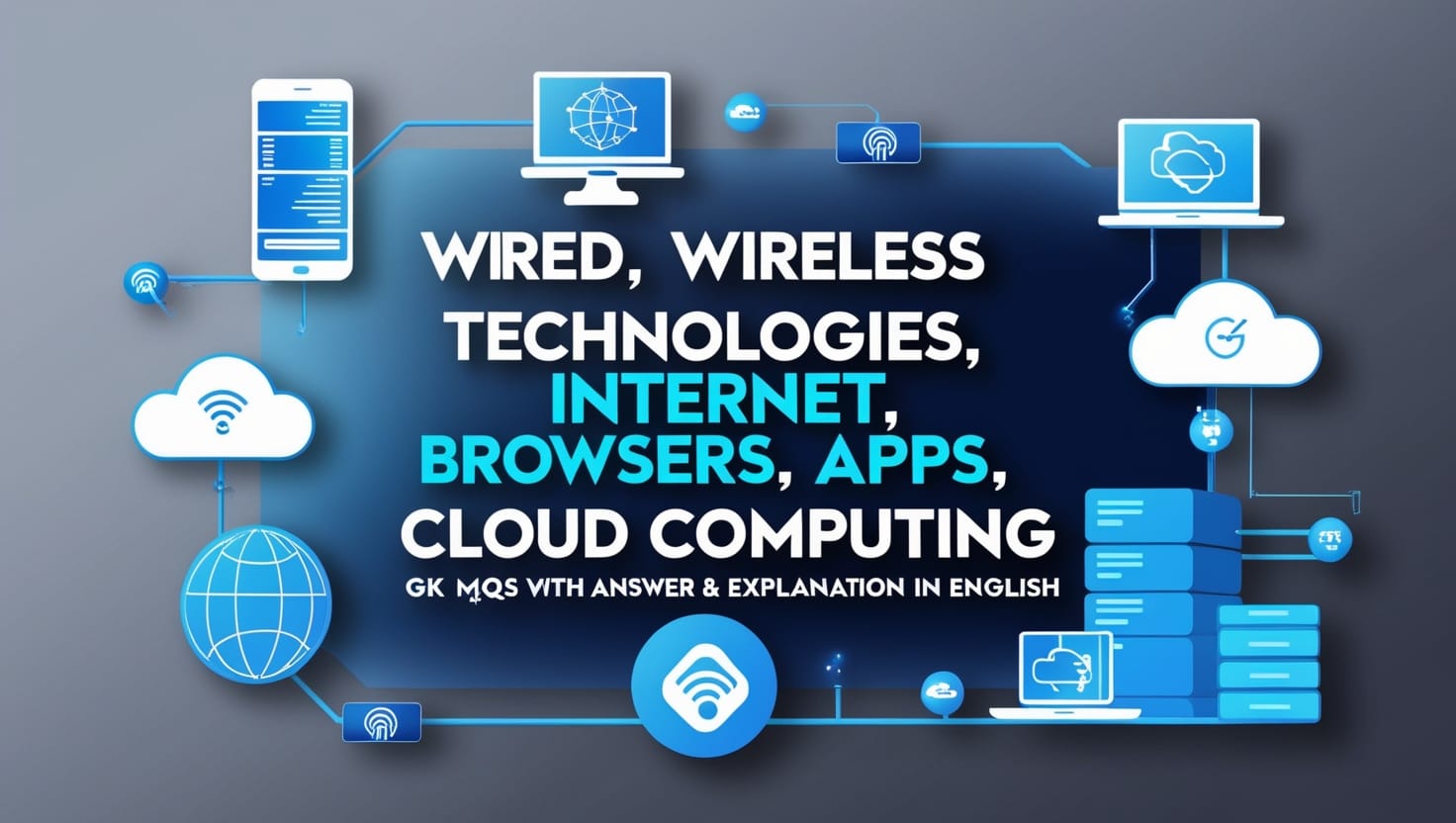
Wired and wireless technologies, internet, browsers, apps, and cloud computing play a significant role in today’s digital age. To help you master these essential topics, we bring you Wired, Wireless Technologies, Internet, Browsers, Apps, Cloud Computing GK MCQs With Answer & Explanation in English. This article is designed to enhance your understanding of these subjects with multiple-choice questions, detailed answers, and explanations to guide your learning.
Whether you’re preparing for exams or just want to expand your knowledge, this comprehensive guide has you covered!
1. What does ADSL stand for?
- Automatic Digital Subscriber Line
- Asymmetric Direct Subscriber Line
- Asymmetric Digital Subscriber Line
- None of these
Show Answer
Answer: Asymmetric Digital Subscriber Line
ADSL is a data communications technology that enables faster data transmission over copper telephone lines. It is known for its asymmetrical nature, which means it provides higher download speeds compared to upload speeds. ADSL leverages the existing telephone infrastructure to transmit data at different frequencies, allowing simultaneous voice and data communication over the same line. This technology is widely used for broadband internet access, where users require faster download speeds for activities like web browsing, streaming, and downloading content, while upload speeds are less critical.
2. What is an Autoresponder?
- Command
- Software
- Program
- None of these
Show Answer
Answer: Software
An autoresponder is a software program designed to automatically respond to incoming emails. It is a valuable tool for managing email communication by sending predefined responses without manual intervention. Autoresponders are commonly used for tasks such as acknowledging receipt of an email, providing immediate information or instructions, or sending out-of-office notifications. They enhance efficiency, improve communication, and ensure a prompt reply to email inquiries.
3. What is the full form of DSLAM?
- Digital Subscriber Line Access Multiplexer
- Digital Subscriber Line Access Multiplier
- Digital Service Line Access Multiplexer
- None of these
Show Answer
Answer: Digital Subscriber Line Access Multiplexer
An autoresponder is a software program designed to automatically respond to incoming emails. It is a valuable tool for managing email communication by sending predefined responses without manual intervention. Autoresponders are commonly used for tasks such as acknowledging receipt of an email, providing immediate information or instructions, or sending out-of-office notifications. They enhance efficiency, improve communication, and ensure a prompt reply to email inquiries.
4. What does Web 2.0 refer to most precisely?
- A New version of Internet
- A Series of technological improvements in World Wide Web
- A New labelling of old Softwares improved
- None of these
Show Answer
Answer: A Series of technological improvements in World Wide Web
Web 2.0 is a concept that represents a series of technological advancements in the World Wide Web. It signifies a shift from static, read-only web content to a more dynamic and interactive online environment. Key characteristics of Web 2.0 include user-generated content, participatory culture, and compatibility with various products and systems. This era of the web has given rise to social media platforms, collaborative tools, and web applications that allow users to create, share, and interact with content in unprecedented ways.
5. BSNL, Reliance, Shaw cable, AOL, Tata Indicom all can be categorised under which group?
- ISDN
- ISP
- IRC
- Icons
Show Answer
Answer: ISP
ISPs are organizations or companies that offer access to the internet and related services to end users. They play a pivotal role in connecting individuals, businesses, and other entities to the global internet infrastructure. Examples of ISPs mentioned include BSNL, Reliance, Shaw Cable, AOL, and Tata Indicom, which provide various types of internet connections such as DSL, cable, fiber, and wireless broadband. ISPs serve as intermediaries that bridge the gap between users and the internet, offering a range of services from basic internet access to web hosting, email, and more.
6. Which among the following is not a web browser?
- SpaceTime
- NeoPlanet
- Sputnik
- MeeGo
Show Answer
Answer: MeeGo
MeeGo is not a web browser. It was a Linux distribution that combined source code from the Moblin and Maemo operating systems. MeeGo was designed primarily for mobile devices, netbooks, and embedded systems. However, it is essential to note that MeeGo has been discontinued, and its development has ceased.
7. Which of these has the highest transmission capacity?
- Twisted pair cables
- Coaxial cables
- Optical fibres
- All have the same
Show Answer
Answer: Optical fibres
Optical fibers are a type of high-capacity transmission medium used in networking and telecommunications. They offer significantly higher data transmission capacity compared to traditional twisted pair cables and coaxial cables. Optical fibers work on the principle of transmitting data using light signals, allowing for rapid data transmission over long distances with minimal signal degradation. Their high bandwidth and immunity to electromagnetic interference make them a popular choice for high-speed internet, long-distance communications, and data transmission in various industries.
8. Which of these standards is used to define Ethernet-based networks?
- IEEE 802.1
- IEEE 802.3
- IEEE 802.7
- IEEE 802.11
Show Answer
Answer: IEEE 802.3
IEEE 802.3 is the standard used to define Ethernet-based networks, addressing various aspects of Ethernet communication.
9. Which of these standards is used to define Fiber Optic connections?
- IEEE 802.1
- IEEE 802.8
- IEEE 802.11
- IEEE 802
Show Answer
Answer: IEEE 802.8
IEEE 802.8 defines the LAN standard for fibre optic media, particularly in token passing computer networks like FDDI.
10. Which of these standards is used to define higher layer LAN protocols?
- IEEE 802.15
- IEEE 802.11
- IEEE 802.7
- IEEE 802.1
Show Answer
Answer: IEEE 802.1
IEEE 802.1 is the standard that deals with higher layer LAN protocols, contributing to the overall LAN architecture.







